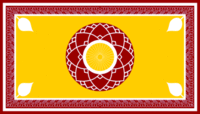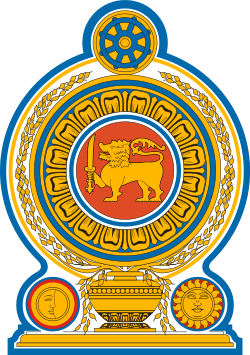Chandrika Kumaratunga
Chandrika Bandaranaike Kumaratunga (Sinhalese: චන්ද්රිකා බණ්ඩාරනායක කුමාරතුංග,Tamil: சந்திரிகா பண்டாரநாயக்கே குமாரதுங்கா; born 29 June 1945) is a Sri Lankan politician who served as the fifth President of Sri Lanka, from 12 November 1994 to 19 November 2005. The country's only female president to date, she is the daughter of two former prime ministers and was the leader of the Sri Lanka Freedom Party (SLFP) until the end of 2005.[1][2][3]
Early life, family, and education
Born Chandrika Bandaranaike comes from an political family with a long history of socio-political involvement in the country. Her father, Solomon Bandaranaike was a government minister at the time of her birth and later became Prime Minister. He was assassinated in 1959, when Chandrika was fourteen. Chandrika's mother, Sirimavo Bandaranaike, then became the world's first female prime minister, in 1960. Chandrika's brother, Anura Bandaranaike is a former Speaker of the Parliament of Sri Lanka and a former minister who died in March 2008. Her sister Sunethra Bandaranaike is a well-known philanthropist and runs the Sunera Trust. Their grandfather, Sir Solomon Dias Bandaranike, was the Maha Mudaliyar, the chief Ceylonese representative and advisor to the Governor of Ceylon during British colonial rule.[4]
Chandrika was educated at the St Bridget's Convent, Colombo, and at the Aquinas University College Colombo where she studied for the bachelor of laws. She gained a scholarship to the University of Paris where she spent five years, graduating from the Institut d'Etudes Politiques de Paris (Sciences Po) in political science and international relations in 1970. While in Paris she obtained a diploma in Group Leadership from the same university and was trained as a political journalist at the Le Monde newspaper. Her PhD studies in Development Economics at the University of Paris 1970–73 were interrupted when she returned to Sri Lanka to enter politics, when her mother’s government had launched a wide-ranging programme of socialist reform and development.[5] During her days in France, it is reported that Chandrika was active in the Student Revolution of 1968.[6] She is fluent in Sinhala, English and French.[7]
She married film star and Sri Lankan politician Vijaya Kumaratunga (also Kumaranatunga) in 1978.
Political career
Upon returning to Sri Lanka, she enrolled in and became active in the Sri Lanka Freedom Party (SLFP) and, in 1974, became an executive committee member of its Women's League. Following the land reforms in Sri Lanka in 1972–1976, she was the principal director of the Land Reform Commission. From 1976 to 1977, she was chairman of the Janawasa Commission, which established collective farms. From 1976 to 1979, she acted as a consultant to the Food and Agriculture Organization of the United Nations.
She stayed active in politics leaving the SLFP and supporting her husband's party, the Sri Lanka Mahajana Party. After Kumaratunga was assassinated, she left the country for the UK, working for World Institute for Development Economics Research at the United Nations University in the interim, and not returning until 1991.
Premiership and presidency
On return to Sri Lanka she rejoined SLFP and led her party to a historic and decisive victory at the southern provincial council elections. Kumaratunga was elected as the chief minister of the Western Province of Sri Lanka in 1993 in a landslide election victory. Kumaratunga herself was elected prime minister of a People's Alliance (PA) government from 19 August 1994 and won the presidential election held shortly thereafter in November. This ended 17 years of United National Party rule. She appointed her mother to succeed her as prime minister. Early in her term she made conciliatory moves towards the separatist Tamil Tigers (LTTE) in an attempt to end the ongoing civil war. After these overtures failed, she later pursued a more military-based strategy against them.
In October 1999, Kumaratunga called an early presidential election.[8] She lost vision in her right eye (permanent optic nerve damage) in an assassination attempt, by the Tamil Tigers, at her final election rally at Colombo Town Hall premises on 18 December 1999. She managed to defeat Ranil Wickremasinghe in the election held on 21 December and was sworn in for another term the next day.[9]


In December 2001 she suffered a setback in the parliamentary election: Her People's Alliance lost to the UNP, and her political opponent, Ranil Wickremasinghe, became Sri Lanka's new prime minister. She continued as president of Sri Lanka although her relationship with the Wickremasinghe government was a strained one.
In February 2002 Wickremasinghe's government and the LTTE signed a permanent ceasefire agreement, paving the way for talks to end the long-running conflict. In December, the government and the rebels agreed to share power during peace talks in Norway. President Kumaratunga believed Wickremasinghe was being too lenient towards the LTTE, and in May 2003 she indicated her willingness to sack the prime minister and government if she felt they were making too many concessions to the rebels. On 4 November 2003, while Prime Minister Wickremasinghe was on an official visit to the US, Kumaratunga prorogued Parliament and took over Defense, Interior and Media ministries herself. Her opponents criticised her, calling her behaviour dictatorial.[10]
Kumaratunga's PA and the leftist Janatha Vimukthi Peramuna or JVP (People's Liberation Front) formed the United People's Freedom Alliance (UPFA) in January 2004 and dissolved Parliament. Having won the election held on 2 April 2004 the UPFA formed a government with Mahinda Rajapaksa as prime minister. This marked the first time in history that the JVP became a partner in a Sri Lankan government.[11]
However, in June 2005, the JVP left Kumaratunga's government over a disagreement regarding a joint mechanism with LTTE rebels sharing foreign aid to rebuild the tsunami-devastated Northern and Eastern areas of Sri Lanka.[12] Kumaratunga's six-year term ended that year. She argued that since the 1999 election had been held one year early, she should be allowed to serve that leftover year. Mahinda Rajapaksa succeeded her as president, leading all 25 parties in the UPFA.
Post-presidency
Kumaratunga is a member of the Council of Women World Leaders, an international network of current and former female presidents and prime ministers whose mission is to mobilise the highest-level women leaders globally for collective action on issues of critical importance to women and equitable development. In November 2009, Kumaratunga was appointed to the 12-member board of directors of the Club de Madrid. She is a frequent panelist and member of the Clinton Global Initiative and advisor to its annual meeting held every September.
Kumaratunga noted in 2007: ″I sincerely tried to reach a political consensus to solve the ethnic question, and tried to introduce a pluralistic constitution that would cater to the political aspirations of the Tamil people without dividing the country.″[13]
On September 2009, Kumaratunga, on a personal visit to Kerala, India told reporters "I too care for my life. Even though the current government is a government of my party (Sri Lanka Freedom Party) I don't feel safe." She continued, "There is an overall lack of freedom and an atmosphere of fear prevails in the country. The basic rights of the people and media freedom are restricted in Sri Lanka." [14]
Chandrika Kumaratunga is a member of the Global Leadership Foundation, a nonprofit organisation that offers, discreetly and confidentially, a range of experienced advisors to political leaders facing difficult situations. It works to support democratic leadership, prevent and resolve conflict through mediation and promote good governance in the form of democratic institutions, open markets, human rights and the rule of law. It does so by making available, discreetly and in confidence, the experience of former leaders to today’s national leaders. It is a nonprofit organisation composed of former heads of government, senior governmental and international organisation officials who work closely with heads of government on governance-related issues of their concern.
Return to politics
On 21 November 2014 Kumaratunga formally announced her return to active politics at a press conference held by the country's opposition coalition, following weeks of speculation regarding her involvement in the coalition's decision-making.[15][16]
Personal life
Chandrika married movie star and politician Vijaya Kumaratunga in 1978. He was assassinated on 16 February 1988, outside his residence in the presence of Chandrika and their two children, then aged five and seven. The extremist Marxist Janatha Vimukthi Peramuna (JVP) claimed responsibility. Kumaratunga's funeral remains to date, the largest-attended funeral of any politician or film idol in Sri Lanka (and potentially in the whole of Asia). Their two children are Yasodhara Kumaratunga Walker (born 1980), a medical doctor (Corpus Christi College, University of Cambridge and St George's Medical School, University of London), and Vimukthi Kumaratunga (born 1982), a veterinary surgeon (University of Bristol), both in the UK.
See also
References
- ↑ "BBC Profile: Chandrika Kumaratunga". BBC News. 26 August 2005.
- ↑ "Chandrika".
- ↑ Skard, Torild "Chandrika Kumaratunga" in Women of Power - half a century of female presidents and prime ministers worldwide, Bristol: Policy Press, 2014, 978-1-44731-578-0
- ↑ Skard, Torild "Sirimavo Bandaranaike" and "Chandrika Kumaratunga", 2014
- ↑ President Kumaratunga, www.priu.gov.lk/execpres/bbk.html; Chandrika Kumaratunga, www.clubmadrid.org/en/miembro/chandrika_kumaratunga, both retrieved 7 Sept 2014
- ↑ BBC News, Profile: Chandrika Kumaratunga, 26 August 2005
- ↑ "Chandrika Kumaratunga: Politics in the blood". BBC News. 9 October 2000.
- ↑ "Presidential poll in Sri Lanka". BBC News. 20 October 1999. Retrieved 28 April 2010.
- ↑ http://news.bbc.co.uk/1/hi/world/south_asia/574780.stm
- ↑ "'Dictatorship' cries after parliament suspended". ABC Radio Australia. 2012. Retrieved 18 August 2016.
- ↑ "Kumaratunga Interview". Time Asia. 22 March 2004.
- ↑ "General Assembly of the United Nations-15 September 2005" (PDF).
- ↑ "The Queen ponders a return". HIMAL South Asian.
- ↑ Talked to reporters in Sep 2009 Archived 13 July 2011 at the Wayback Machine.
- ↑ "Fresh moves by CBK". DailyMirror Sri Lanka. 7 November 2014.
- ↑ "Chandrika Announces Her Return To Active Politics After Nine Years". Asian Mirror. 21 November 2014.
External links
| Wikimedia Commons has media related to Chandrika Kumaratunga. |
| Wikiquote has quotations related to: Chandrika Kumaratunga |
- The Bandaranaike Ancestry
- The Ratwatte Ancestry
- Economic and political agenda of a people's President
- Chandrika Kumaratunga's official website
- Sri Lanka Freedom Party's official Website
- Profile by BBC
- Search BBC for news about Chandrika Kumaratunga
- Ministry of Defence : Sri Lanka
- Profile of Mrs. Chandrika Kumaratunga on Sri Lankan government website
- Personal reminiscence of meeting with the Sri Lankan President by S. Abbas Raza of 3 Quarks Daily.
| Political offices | ||
|---|---|---|
| Preceded by Ranil Wickremesinghe |
Prime Minister of Sri Lanka 1994 |
Succeeded by Sirimavo Bandaranaike |
| Preceded by Dingiri Banda Wijetunga |
President of Sri Lanka 1994–2005 |
Succeeded by Mahinda Rajapaksa |


